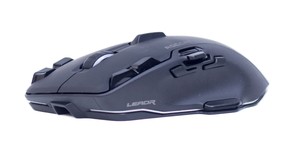
Gaming peripherals maker Roccat has announced that it is to finally bring its Phobo gaming keyboard concept, first unveiled in 2012, to market in late 2015.
Roccat's original Phobo design concept was an odd duck: ostensibly a gaming keyboard, the device included a slot for connection to a smartphone. While seemingly abandoned by the company, the continuing growth in mobile gaming and increasing power of smartphone devices appears to have given the company cause to think again - with the result that the Phobo, now known as the Ryos Phobo, will hit the market later this year in a redesigned form.
'When concepting Phobo, we knew we had a strong vision,' claimed René Korte, chief executive and founder of Roccat, at the device's unveiling during the Consumer Electronics Show (CES) in Las Vegas this week. 'Still, we brought it back to the drawing board to expand and perfect the design. I’m glad we held off on the original Phobo concept. What was once a great idea will now be a superior reality our loyal fans can hold in their hands.'
The redesigned Ryos Phobo acts as a perfectly straightforward gaming keyboard, featuring Cherry MX mechanical switches, a compact tenkeyless design and a pair of upstream USB ports for connection to additional peripherals. Where it takes an abrupt left-turn from the norm is in the inclusion of a bundled wireless dock, which supports 'smartphones of all brands and sizes' and connects directly to the keyboard over a pair of Bluetooth channels. A bundled smartphone app then allows integration between the two, using the smartphone as a means of keeping an eye on the PC: CPU load, memory, network and storage usage, and even GPU temperature can be seen at-a-glance, while the touch-centric interface allows for quick access to media controls and other commonly-used shortcuts including web searches and incoming emails.
Roccat's CES announcements also included mechanical gaming keyboards featuring RGB LED backlighting, the Ryos MK FX and Ryos TKL FX, along with its latest Nyth gaming mouse featuring interchangeable buttons and side-parts linked to a library of 3D printable designs, and a new Kave XTD 5.1 Analogue headset featuring noise cancellation and in-cable remote along with a 25 per cent weight reduction over its predecessor.
Pricing for the company's latest designs has yet to be announced.
Roccat's original Phobo design concept was an odd duck: ostensibly a gaming keyboard, the device included a slot for connection to a smartphone. While seemingly abandoned by the company, the continuing growth in mobile gaming and increasing power of smartphone devices appears to have given the company cause to think again - with the result that the Phobo, now known as the Ryos Phobo, will hit the market later this year in a redesigned form.
'When concepting Phobo, we knew we had a strong vision,' claimed René Korte, chief executive and founder of Roccat, at the device's unveiling during the Consumer Electronics Show (CES) in Las Vegas this week. 'Still, we brought it back to the drawing board to expand and perfect the design. I’m glad we held off on the original Phobo concept. What was once a great idea will now be a superior reality our loyal fans can hold in their hands.'
The redesigned Ryos Phobo acts as a perfectly straightforward gaming keyboard, featuring Cherry MX mechanical switches, a compact tenkeyless design and a pair of upstream USB ports for connection to additional peripherals. Where it takes an abrupt left-turn from the norm is in the inclusion of a bundled wireless dock, which supports 'smartphones of all brands and sizes' and connects directly to the keyboard over a pair of Bluetooth channels. A bundled smartphone app then allows integration between the two, using the smartphone as a means of keeping an eye on the PC: CPU load, memory, network and storage usage, and even GPU temperature can be seen at-a-glance, while the touch-centric interface allows for quick access to media controls and other commonly-used shortcuts including web searches and incoming emails.
Roccat's CES announcements also included mechanical gaming keyboards featuring RGB LED backlighting, the Ryos MK FX and Ryos TKL FX, along with its latest Nyth gaming mouse featuring interchangeable buttons and side-parts linked to a library of 3D printable designs, and a new Kave XTD 5.1 Analogue headset featuring noise cancellation and in-cable remote along with a 25 per cent weight reduction over its predecessor.
Pricing for the company's latest designs has yet to be announced.

MSI MPG Velox 100R Chassis Review
October 14 2021 | 15:04








Want to comment? Please log in.